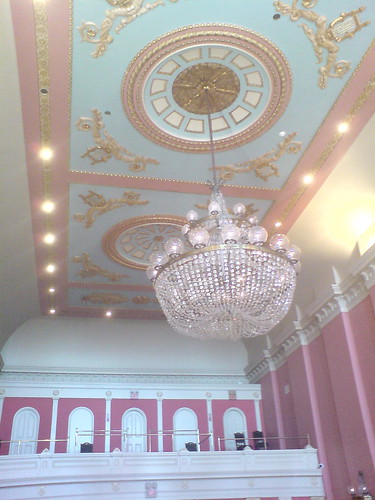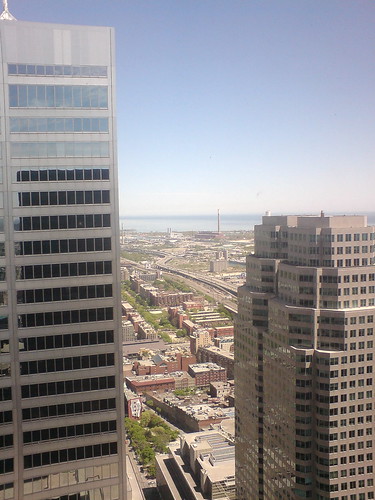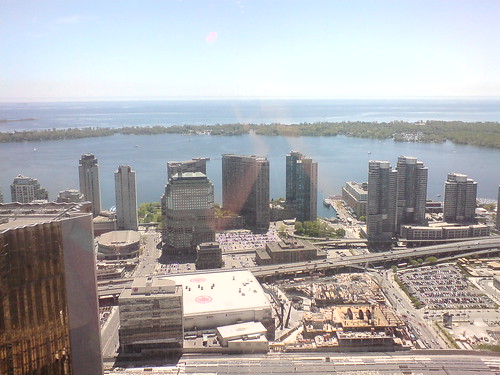
Although I don’t often go there myself, except to pass through on my way to Union Station or to meet my dad after work at his office, the central business district of Toronto has significantly shaped my perception of the city. The business towers that line the streets of King, Bay, and Adelaide, amongst others, dominate the city’s southern skyline, and attest to the city’s ambitions as a world economic leader. So for this year’s Doors Open, I decided to visit a few of the monumental buildings that have contributed to the rise of Toronto’s downtown.

I started at 157 King St. East, St. Lawrence Hall. Although not a financial institution, and certainly not a tower, I started here because it represents the old core of the city — built in 1850 to host public meetings and performances, it was the centre of the city’s cultural life. Adjacent to Toronto’s first official city hall building (in what is now St. Lawrence Market), and the still standing Cathedral Church of St. James, St. Lawrence Hall was an important venue in the burgeoning city until the 1920s, when the city’s centre began moving west. I particularly enjoyed the Great Hall on the third floor. Carefully preserved, gas-fired bulbs illuminated the orbs of the crystal chandelier that hangs from the middle of the ornate gilded ceiling. The tall windows along the back and sides of the hall were open, allowing a breeze to pass through, and calling me over for a view. As I stood in the billowing curtains and looked out to St. Lawrence Market to the south I began to see a side of Toronto that is sometimes hard to find — the city in its youth, as it was setting down its humble foundations, unaware of the massive change just on the horizon.

After a short walk down King St., I stood in front of 25 King St. West, Commerce Court North. Designed in 1927 and completed in 1930 for the Canadian Bank of Commerce, the 34-storey tower was the tallest in the Commonwealth for just over thirty years, and represents the beginning of Toronto’s reach for the sky. Inside, the Banking Hall’s vaulted, gold-coffered ceiling soared high above me, echoing a classical Roman bath. Parts of the Banking Hall are now cordoned off for offices, which I thought was unfortunate because it would have been nice to get the full effect of the space as it was originally intended, but photographs helped recreate the overall experience of the building as it might have been during its reign over the city. One in particular, of a family on the now closed observation deck on the 32nd floor, looking out past the enormous carvings that hang from the deck, speaks to an experience that must have been incredible for the time — to observe the city from its tallest point as it was growing up and out from this seed of development.

A block away, at 66 Wellington, I waited in line to visit the 54th floor of the Toronto Dominion Centre. Exemplary of the International Style, it was designed by Mies van der Rohe and opened in 1967. In contrast to the Banking Hall at Commerce Court North (solid, heavy, and enveloping) the expansive lobby of this tower is barely there; except for the transparent glass walls and travertine-clad elevator cores, the space runs seamlessly from the plinth in front of the building into the open plaza behind it. But much like Commerce Court North, the building is an optimistic, unabashed, monument to the age, reflecting the values and ambitions of the time (and likewise, was the tallest tower built in Canada when it opened). On the 54th floor, walking between the TD executive boardroom and the old office of the chairman, it is hard not to appreciate the vision of the space — clear, ordered, and efficient, it was a built manifestation of the modern dream. Yet as I sat in a still-stunning original Brno chair, and looked east out the window at an unbelievably expansive view, my ears pricked as the docent, a volunteer from Heritage Toronto, pointed down to a seemingly small patch of grass below at Berczy Park, and talked about the history of the old centre of Toronto and St. Lawrence Hall.

I could barely reconcile where I started my Doors Open trip with where I was sitting at the end, let alone understand how in such a short period of time Toronto grew from such modest roots into something so enormous. Looking out again to the incredible agglomeration of buildings, cars, people and infrastructure in every possible direction, some of it left over from the nineteenth century but much of it relatively modern, I could only wonder what was next on the horizon for Toronto, and to what heights the city might be reaching for in another few years.
Lead photo by Dennis Marciniak, other photos by Matthew Hague




One comment
I also went to the TD Centre last weekend. It was fascinating to hear about when that dark black building dominated the skyline. I later noticed, by amazing coincidence, that 2001:Space Odyssey, with its recurring black monoliths, opened in theatres one year after the skyscraper was built!